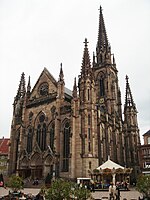Riedisheim
Communes of Haut-RhinHaut-Rhin geography stubsPages including recorded pronunciationsPages with Alemannic German IPAPages with French IPA ... and 1 more
Pages with disabled graphs

Riedisheim (French pronunciation: [ʁidisaim] ), in Alsatian Riadasa (Alemannic German pronunciation: [ˈʁia̯dasa]), is a commune in the Haut-Rhin department, Alsace, region of Grand Est, northeastern France. It forms part of the Mulhouse Alsace Agglomération, the inter-communal local government body for the Mulhouse conurbation.
Excerpt from the Wikipedia article Riedisheim (License: CC BY-SA 3.0, Authors, Images).Riedisheim
Rue du Maréchal Foch, Mulhouse
Geographical coordinates (GPS) Address Nearby Places Show on map
Geographical coordinates (GPS)
| Latitude | Longitude |
|---|---|
| N 47.7489 ° | E 7.3675 ° |
Address
Rue du Maréchal Foch 32
68400 Mulhouse
Grand Est, France
Open on Google Maps








